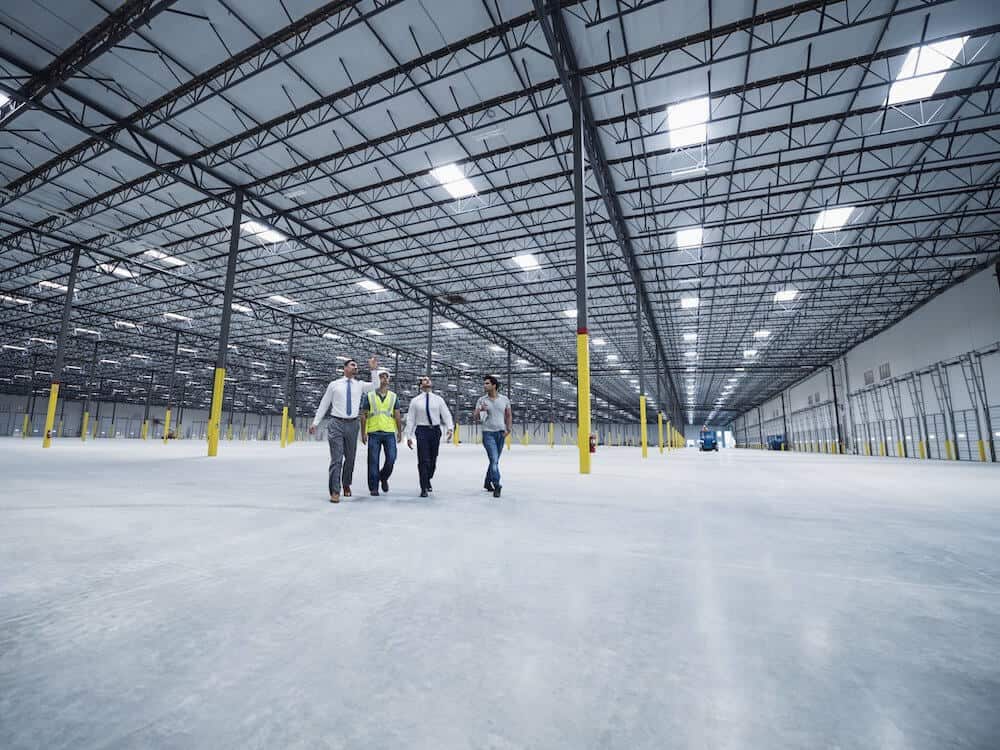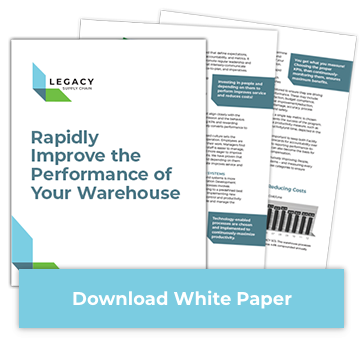9 Things to Consider When Choosing a New Warehouse Location

Whether you intend to lease or build your warehouse and operate it yourself, or outsource your warehouse to a third party, the location of your warehouse has downstream effects on everything from your access to a skilled workforce to your ability to deliver goods on time. For that reason, you must take a holistic approach to choosing the location of your warehouse.
To help you make the right decision, we’ve put together this list of the 10 factors to consider when selecting a warehouse.
Customer Base
The first question you should ask when conducting warehouse location planning is “Where are my customers located?”
If your customers are primarily located, say, in the Pacific Northwest, you likely only need one warehouse centrally located in that region. If, however, you provide service throughout North America it makes sense to have multiple different facilities across the country near major transportation hubs.
Given that consumer expectations around delivery have risen to dizzying heights, stationing your warehouse (or warehouses, as it may be) close to your customer base makes it easier to satisfy that demand and provide faster, more affordable shipping.
Supplier Network
Once you’ve determined where your customer base is located, the next question to ask is “Where do I receive goods from?” Proximity to suppliers should play a major role in warehouse selection as being close to your suppliers allows you to reduce inventory carrying and transportation costs; it also reduces the risk of potential disruption for goods in transit.
This holds true for both domestic and international suppliers. If, for example, you primarily source materials out of China or somewhere else in the APAC region, it usually makes sense to have either a warehousing facility on the West Coast, or an import warehouse that is dedicated to feeding the rest of your distribution network.
Foreign Trade Zones (FTZs)
Speaking of international supply chains, if your supplier network for components or raw materials is primarily located outside of the United States, it may be advantageous to seek an active foreign trade zone warehouse. There are numerous benefits to using an FTZ, including the deferral or elimination of duties, tariff and tax relief, greater inventory visibility, and more.
Proximity to Transportation
What mode or modes of transportation do you typically use to ship and receive goods — air? Train? Trucking? Parcel?
As we mentioned earlier, consumer expectations around delivery are at an all-time high. One of the best ways to optimize for customer satisfaction is to factor proximity to transportation carrier services into your warehouse location selection process.
Choosing a warehouse location near your primary mode of transportation, such as a port if you predominantly import and export via ocean, can help reduce drayage costs and enable you to move more containers within a given period.
Ideally, you’ll locate your warehouse close to parcel or intermodal transit hubs, such as the Memphis Intermodal Facility and Indianapolis Parcel Hub. Your eCommerce fulfillment needs should be heavily factored into how close your warehouses need to be to parcel hubs.
Or, if you are a heavy LTL shipper or rely on last-mile delivery services you may want to consider which carriers have terminals close to your warehouse, as this can improve the level of service you receive.
If you are unable to source a warehouse close to your primary mode of transportation or an intermodal hub, you’ll want to look for a location with access to major roadways for a more direct connection. If possible, look for a warehouse location that’s centrally located relative to customers, suppliers and carriers.
Building Availability and Expandability
This one might seem obvious — you can’t access a warehouse in a particular area if there aren’t any available — but it’s still worth mentioning. Building availability goes far beyond immediate site selection; it can actually affect your ability to scale your business over time.
Think of it this way: Let’s say you’re able to secure a facility in a prime location, one that puts you in proximity to both your customers and your suppliers. Now, imagine that five years down the road, your operations have doubled, and you desperately need additional warehouse space to accommodate your growing business. The only problem is that, because you chose to locate your warehouse in an incredibly competitive area, there are no other warehouses available for expansion. Now you’re faced with a significant logistical challenge and need to start the warehouse location selection process all over again.
None of this is meant to deter you from choosing a warehouse in a competitive market — after all, you need to do what’s right for your business. Instead, it should encourage to keep the bigger picture in mind when engaging in the site selection process for a warehouse.
Lease Rates
Cost is, of course, one of the key selection criteria for warehouse location. Naturally, warehouse space in high-cost markets such as San Francisco, Long Island and San Diego comes with higher lease rates than space in low cost markets such as Memphis, Dallas-Ft. Worth and Atlanta.
According to CBRE’s 2020 Real Estate Market Outlook Report, the average asking price for rent per square foot for U.S. warehouses rose 4.8% to $7.86 over 12 months due to the unprecedented volume of online sales and tightening of warehouse capacity. That number is expected to rise even higher in 2021.
The same logic applies for retailers and distributors looking to build or purchase warehouse space: The more desirable the market, the more challenging it will be to find available space.
Tax Structures & Incentives
Tax structures and incentives also have a major impact on warehousing costs, both directly and indirectly. When evaluating possible warehouse locations, pay close attention to business-related taxes including inventory tax, franchise tax and …, as well as personal taxes that will affect you and your employees such as income tax, sales tax and property tax rates.
It’s also important to look for potential tax incentives to offset costs. For example, Legacy operates in Mississippi and Nevada, both areas offer our customers significant business incentives and tax relief options that are very beneficial. We also believe in maintaining close, strategic relationships with economic development associations in key markets as those groups become important resources to identify and take advantage of these types of benefits. To that end, if you’re interested in leasing warehouse space, you should look for a partner that can offer you tax benefits, in addition to researching local tax structures and incentives.
Environmental Conditions & Restrictions
Certain parts of the country are more prone to natural disasters, such as earthquakes, hurricanes, tornados, flooding and snowstorms, which can disrupt the supply chain. For retailers and distributors looking to build their own warehouse, local environmental factors can affect building requirements. Although every location is subject to inclement weather to some degree, it’s important to keep in mind when choosing a location for your warehouse.
Beyond weather and climate, retailers and distributors should also consider traffic and truck access. Peak traffic hours and the level of congestion vary from one location to the next and can affect delivery times. As far as truck access is concerned, many areas, including some industrial zones, have restrictions on when trucks can pick up and deliver.
Workforce Availability
Historically, warehouses have always employed a blend of full-time workers and temporary associates. Over the years, the available pool of skilled laborers has become shallower for a multitude of reasons, forcing retailers and distributors to become more competitive, typically by offering higher wages, flex scheduling and other benefits. The COVID-19 pandemic has made this pool even more limited, due to the public health incentive of staying at home, though this will likely ebb and flow over the coming year.
When scouting warehouse locations, workforce availability needs to be top of mind. In addition to the challenge of finding skilled workers; you may have to be creative in terms of how you get laborers to the job site, which could increase costs in the long run. Your overall recruiting strategy and tactical efforts will need to align with the market. Alternatively, urban warehouse locations are becoming a trend as they boast a much larger labor pool due to their higher population density and access to public transportation, however, they tend to cost more on the whole.
Unfortunately, there’s no simple answer as to whether it makes more practical sense to look for a warehouse in a rural or an urban area; be sure to research demographics in any area you’re considering, as well as local educational programs and state and city income levels, to make an informed decision.
These are just 8 factors to consider when selecting a warehouse location; there are undoubtedly many more to keep in mind depending on your business’ unique requirements.
If you’re interested in exploring warehousing options, Legacy Supply Chain offers a wide range of warehousing services, including dedicated contract warehousing and multi-client/shared warehousing. Talk to one of our supply chain specialists today to see which option — and which location — makes the most sense for you.
Get Insights. Stay Ahead.
Get the latest news and insights via email on warehouse improvement, transportation optimization, labor strikes and international shipping rate changes.Popular Posts
Search Posts
-
2024 Q1 Freight Landscape: Trends, Challenges, and Predictions
As the first quarter of 2024 comes to an end, here are some observations over the past few months as well as predictions about the trucking...
+ Read more -
Baltimore Bridge Impact Assessment – Update
Following the recent Baltimore Bridge collapse and subsequent port closures, we want to keep our customers informed about the situation and...
+ Read more -
Global Momentum Builds for Charge on Global Shipping Sector’s CO2 Emissions
A growing coalition of 47 countries, including key players like the European Union, Canada, Japan, and various Pacific Island nations, is...
+ Read more










